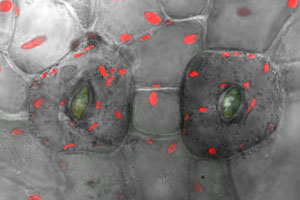Evolutionary conservation explains similar genetic mechanism between flowering plants and mosses

An international team has discovered a genetic mechanism that is responsible for the development of stomata - microscopic valves on the surface of plants that facilitate the uptake of carbon dioxide and the release of oxygen and water vapor. The researchers discovered this mechanism, which was previously known in flowering plants like Arabidopsis thaliana, in the moss Physcomitrella patens and found similarities between the two, implying that it already existed in the last common ancestor of mosses and flowering plants. The team was led by the biologists Professor Ralf Reski from the University of Freiburg/Germany and Professor David J. Beerling from the University of Sheffield/UK. The results were published in the journal Nature Plants.
Stomata came into being more than 400 million years ago when the first plants colonized the hitherto hostile land masses. Because stomata facilitate an efficient gas exchange with the atmosphere, they enabled the spread of plants and the subsequent evolution of our complex ecosystems. In contrast to more developed vascular plants with roots, stems, leaves, and vasculature, which are necessary for the transport of water and nutrients, it remained unclear in the case of mosses, which have no vasculature, which genes are responsible for the development of stomata.
The research team found that an interaction between the two proteins PpSMF1 and PpSCRM1 in Physcomitrella is the trigger responsible for the development of stomata in moss. When they deleted one of these genes, moss developed without stomata. The researchers found that this mechanism is similar to the interaction of the two proteins MUTE and FAMA, which triggers the development of stomata in Arabidopsis. The genes which encode these proteins therefore originate from the last common ancestor of mosses and flowering plants - the prehistoric plants which left the fresh water to dwell on rocks and thus laid the foundation for the development of all current ecosystems on the mainland.
"Our results show that the development of stomata originated over 400 million years ago and predated the development of roots, stems, and leaves," explains Reski. "This evolutionary innovation fundamentally changed the global cycles of carbon, water, and energy and thus was a prerequisite for all life forms on the mainland, including us humans."
More information: Caspar C. Chater et al. Origin and function of stomata in the moss Physcomitrella patens, Nature Plants (2016). DOI: 10.1038/nplants.2016.179
Journal information: Nature Plants
Provided by Albert Ludwigs University of Freiburg


















